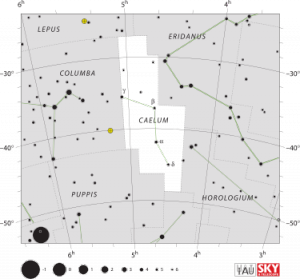Caelum: Difference between revisions
(Created page with "Caelum is a faint constellation in the southern sky, introduced in the 1750s by Nicolas Louis de Lacaille. Its name means "the chisel" in Latin, and it was formerly known as C...") |
No edit summary |
||
| Line 1: | Line 1: | ||
[[File:375px-Caelum IAU.svg.png|thumb|Caelum]] | |||
Caelum is a faint constellation in the southern sky, introduced in the 1750s by Nicolas Louis de Lacaille. Its name means "the chisel" in Latin, and it was formerly known as Caelum Scalptorium ("the engraver's chisel"). It is the eighth-smallest constellation, and subtends a solid angle of around 0.038 steradians, just less than that of Corona Australis. | Caelum is a faint constellation in the southern sky, introduced in the 1750s by Nicolas Louis de Lacaille. Its name means "the chisel" in Latin, and it was formerly known as Caelum Scalptorium ("the engraver's chisel"). It is the eighth-smallest constellation, and subtends a solid angle of around 0.038 steradians, just less than that of Corona Australis. | ||
Due to its small size and location away from the plane of the Milky Way, Caelum is a rather barren constellation, with few objects of interest. The constellation's brightest star, Alpha Caeli, is only of magnitude 4.45, and only one other star (Gamma1 Caeli) is brighter than magnitude 5. Other notable objects in Caelum are RR Caeli, a binary star with one planet approximately 20.13 parsecs (65.7 ly) away; X Caeli, a Delta Scuti variable that forms an optical double with Gamma1Caeli; and HE0450-2958, a Seyfert galaxy that at first appeared as just a jet with no host galaxy visible. | Due to its small size and location away from the plane of the Milky Way, Caelum is a rather barren constellation, with few objects of interest. The constellation's brightest star, Alpha Caeli, is only of magnitude 4.45, and only one other star (Gamma1 Caeli) is brighter than magnitude 5. Other notable objects in Caelum are RR Caeli, a binary star with one planet approximately 20.13 parsecs (65.7 ly) away; X Caeli, a Delta Scuti variable that forms an optical double with Gamma1Caeli; and HE0450-2958, a Seyfert galaxy that at first appeared as just a jet with no host galaxy visible. | ||
Revision as of 23:20, 21 March 2015
Caelum is a faint constellation in the southern sky, introduced in the 1750s by Nicolas Louis de Lacaille. Its name means "the chisel" in Latin, and it was formerly known as Caelum Scalptorium ("the engraver's chisel"). It is the eighth-smallest constellation, and subtends a solid angle of around 0.038 steradians, just less than that of Corona Australis. Due to its small size and location away from the plane of the Milky Way, Caelum is a rather barren constellation, with few objects of interest. The constellation's brightest star, Alpha Caeli, is only of magnitude 4.45, and only one other star (Gamma1 Caeli) is brighter than magnitude 5. Other notable objects in Caelum are RR Caeli, a binary star with one planet approximately 20.13 parsecs (65.7 ly) away; X Caeli, a Delta Scuti variable that forms an optical double with Gamma1Caeli; and HE0450-2958, a Seyfert galaxy that at first appeared as just a jet with no host galaxy visible.
Caelum is bordered by Dorado and Pictor to the south, Horologium and Eridanus to the east,Lepus to the north, and Columba to the west. Covering 125 square degrees, it ranks 81st of the 88 modern constellations in size. It appears prominently in the southern sky during the Southern Hemisphere's summer, and the whole constellation is visible for at least part of the year to observers south of latitude 41°N.
References
Found in HGS Manual on Page 108 Found in HGS Manual on Page 115


